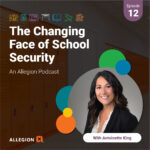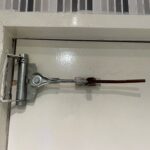Question: I was told that I couldn’t use dogging on fire exit hardware installed on fire doors. Is it acceptable to use electric dogging?
Answer: The short answer is “yes.” Here’s the longer answer:
One of the cardinal rules of fire doors is that they need to be “self-latching.” During a fire, a fire door must be positively latched in order to withstand the pressures created by the fire, and compartmentalize the building to prevent the spread of smoke, flames, and gases.
Generally this means that every fire door must be equipped with an active latchbolt, so that when the door comes to a close, it will latch. The latchbolt of a lockset or fire exit hardware would provide this positive latch. A deadbolt, roller latch, magnetic catch, or electromagnetic lock would not. A fail safe electric strike would not provide a positive-latch condition upon loss of power, so only fail secure electric strikes may be used on fire doors.
In some cases, the positive latch required for a fire door will interfere with the desired function of the door. For example, in a hospital corridor the doors are often equipped with automatic operators, so the preferred operation would be a push/pull function without positive latching. The International Building Code requires fire doors to have a positive latch, but the requirement is addressed in more detail in NFPA 80 – Standard for Fire Doors and Other Opening Protectives. NFPA 80 allows fire doors to be equipped with hardware which does not latch each time the door closes, but positively latches upon fire alarm. This accomplishes the requirements for the fire door to be latched when there is a fire, and also provides the desired functionality.
Here is the section from the editions of NFPA 80 published since 2007, which addresses this application.
6.4.4.3.3 Latching arrangements that do not provide positive latching in the normal mode shall be permitted to be used provided that, in a fire emergency, the door becomes positively latched by means of an automatic fail-safe device that is activated by an automatic fire detector. (See Section 4.7.)
The 1999 edition of NFPA 80 had the same requirement but it was shown as an exception to the latching requirement:
2-4.4.3 All single doors and active leaves of pairs of doors shall be provided with an active latch bolt that cannot be held in a retracted position as specified in Table 2-4.4.3.
Exception No. 1: Doors other than those used in means of egress shall be permitted to be provided with dead bolts in addition to the active latch bolts or as otherwise permitted by the authority having jurisdiction.
Exception No. 2: Locks with dead bolts that are interconnected with latch bolts and retract when the latch bolt is retracted shall be permitted for use on fire doors within a means of egress.
Exception No. 3: Latching arrangements that do not provide positive latching in the normal mode shall be permitted to be used provided that, in a fire emergency, the door becomes positively latched by means of an automatic fail-safe device that is activated by an automatic fire detector. (See Section 1-10.)
Fire exit hardware cannot be equipped with mechanical dogging, which holds the latch retracted with the use of a key or hex-wrench. To comply with the NFPA 80 requirements above, fire exit hardware is equipped with electric latch retraction (ELR). These devices operate like normal panic hardware for egress – pushing the touchpad will allow free egress at all times. The ELR feature retracts the latch using electricity, and when power is removed, the latch automatically projects and the door becomes latched.
An electric strike on a fire door should operate in the same manner. If the access control system allows an electric strike to remain unlocked for maintained periods, it’s possible that the strike keeper could be free during a fire emergency and allow the door to open. Both of these applications require a fire alarm contact within the system to cut power to the hardware upon fire alarm and ensure positive latching.
You need to login or register to bookmark/favorite this content.






I had not thought of this issue before Jerry brought it to my attention in a discussion of a pair of fire doors with automatic operator. Thanks for posting the code reference.